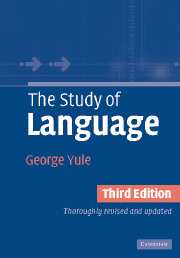Book contents
- Frontmatter
- Contents
- Preface
- The origins of language
- Animals and human language
- The development of writing
- The sounds of language
- The sound patterns of language
- Words and word-formation processes
- Morphology
- Phrases and sentences : grammar
- Syntax
- Semantics
- Pragmatics
- Discourse analysis
- Language and the brain
- First language acquisition
- Second language acquisition/learning
- Gestures and sign languages
- Language history and change
- Language and regional variation
- Language and social variation
- Language and culture
- Appendix: Suggested answers to study questions
- Glossary
- References
- Index
Appendix: Suggested answers to study questions
- Frontmatter
- Contents
- Preface
- The origins of language
- Animals and human language
- The development of writing
- The sounds of language
- The sound patterns of language
- Words and word-formation processes
- Morphology
- Phrases and sentences : grammar
- Syntax
- Semantics
- Pragmatics
- Discourse analysis
- Language and the brain
- First language acquisition
- Second language acquisition/learning
- Gestures and sign languages
- Language history and change
- Language and regional variation
- Language and social variation
- Language and culture
- Appendix: Suggested answers to study questions
- Glossary
- References
- Index
Summary
The origins of language
1 The physical adaptation source
2 Primitive words could have been imitations of the natural sounds that early humans heard around them and all modern languages have words that are onomatopoeic (like bow-wow).
3 Interjections contain sounds that are not otherwise used in ordinary speech production. They are usually produced with sudden intakes of breath, which is the opposite of ordinary talk, produced on exhaled breath.
4 Human teeth are upright, not slanting outwards like those of apes, and they are roughly even in height.
5 The pharynx is above the larynx (or the voice box or the vocal cords). When the larynx moved lower, the pharynx became longer and acted as a resonator, resulting in increased range and clarity of sounds produced via the larynx.
6 If these deaf children do not develop speech first, then their language ability would not seem to depend on those physical adaptations of the teeth, larynx, etc., that are involved in speaking. If all children (including those born deaf) can acquire language at about the same time, they must be born with a special capacity to do so. The conclusion is that it must be innate and hence genetically determined.
Animals and human language
1 One example of the cultural transmission of language is a child with physical features inherited from its natural parents (e.g. Korean) who, if adopted at birth by English speakers, will grow up speaking English (and not Korean).
2 With productivity, the system can create new expressions and the potential number of expressions is infinite. With fixed reference, there is a fixed number of signals in the system and each signal only relates to a particular object or occasion.
3 […]
- Type
- Chapter
- Information
- The Study of Language , pp. 228 - 235Publisher: Cambridge University PressPrint publication year: 2005



